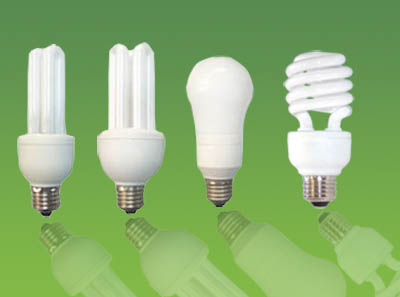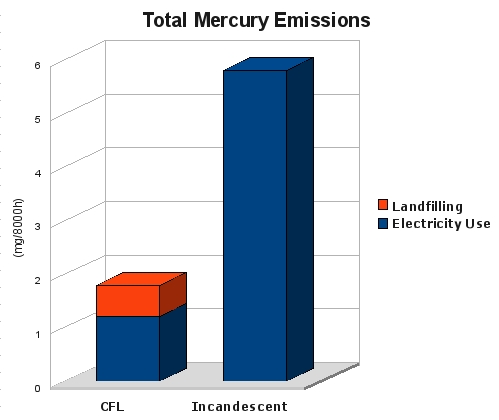|
Energy efficient light bulbs should have already replaced your old fashioned incandescent bulbs.
|

|
Comparison
- Energy Consumption CFL bulbs have a higher percentage on converting electricity to light (17%-21%), whereas incandescent bulbs convert only the 10% of electricity into light (the rest is radiated as heat). In addition, energy efficient light bulbs produce more light (called lumens) per watt, which is around 60-72 lm/W whereas incandescent bulbs convert only 8-17 lm/W Combining these two advantages of compact fluorescent light bulbs, we achieve enormous energy sustainability standards. It was calculated that CFLs reduce overall energy use for lighting by 60%-70%.
- Lifespan Energy efficient light bulbs will last for around 6,000 to 15,000 operating hours. On the other hand, old fashioned lambs will last for 750 to 1,000 operating hours. Using less energy for longer period means more savings, isn't that clear? Well, Energy Star guarantees that an ENERGY STAR qualified compact fluorescent light bulb (CFL) will save about $30 over its lifetime and pay for itself in about 6 months. It uses 75% less energy and lasts about 10 times longer than an incandescent bulb.
- Cost The truth is that CFL's cost about 3 to 10 times more than equivalent incandescent lamps. However, they have a longer lifespan and consume less energy. For instance, it is calculated that a 15w CFL (60w equivalent) will save more than $40 in energy costs and more than $68 in combined costs, over its lifetime. Replacing all your incandescents with CFL bulbs, may save you up to 12% of your utility bills.
- Mercury Recently, there is a lot of conversation being made about mercury and the environmental effects of the use of energy efficient light bulbs. Here is the bare truth. Yes, there is a very small amount (an average of 4mg) of mercury in the tube of CFLs, while some manufacturers announced less than 1.5 to 2.5 milligrams (someone is doing a good job out there). However, CFL bulbs are greener than incandescents (where there is no mercury).
- No mercury is released unless the glass tube is broken. Nor while they are inactive neither while being in use. Thus, compact fluorescent bulbs MUST be handled with care and we HAVE TO recycle them after use. If broken, we shall act in a specific way to prevent unwanted situations. Find out more recycling facts for a greener living.
- They consume less energy This means that less greenhouse gases (one of which is mercury) are emitted during the electricity production.
- How to buy
- "Green" Conclusion Energy efficient light bulbs provide plenty of advantages to both of your pocket and the environment. It is up to you to change all of your old light fixtures and start saving money tomorrow. Thank God this will preserve our planet too...
Have a look at the energy-star qualified CFL list and learn more about energy efficient appliances.
Why? Because of two reasons:
The table below shows an energy star qualified CFL compared to a regular incandescent bulb. The average mercury emissions for electricity production using fossil fuels, are set to 0.012 mg/kWh

| Light Bulb Type | Watts | Hours of Use | kWh | Mercury from Electricity Use (mg) | Mercury from Landfilling (mg) | Total Mercury Emissions (mg) |
| CFL | 13 | 8000 | 104 | 1.2 | 0.6 | 1.8 |
| Incandescent | 60 | 480 | 5.8 | 0 | 5.8 |
| Incandescent Bulbs (watts) |
Minimum Light Output (lumens) |
Energy-Star Qualified CFLs (watts) |
| 40 | 450 | 9 to 13 |
| 60 | 800 | 13 to 15 |
| 75 | 1,100 | 18 to 25 |
| 100 | 1,600 | 23 to 30 |
| 150 | 2,600 | 30 to 52 |
| Warm White/ Soft White Standard color of incandescent bulbs |
Cool White/ Bright White Good for kitchens and work spaces |
Natural/ Daylight Good for rooms - reading |
 |  |  |
| 2700K 3000K | 3500K 4100K | 5000K 6500K |
Note that the use of dimmers and three way-sockets requires special types of CFL's
Now, you are ready to set your own specifications and find the best energy efficient light bulbs for you.
| CFL | Inc | |
| Electricity to light: | 17%-21% | <10% |
| Lumens per Watt: | 60-72 lm/W | 8-17 lm/W |
| Overall energy use: | A*30% | A |
| Lifespan: | 6,000-15,000 h | 750-1,000 h |
| Mercury (8000h): | 1.8 mg | 5.8 mg |
Learn more about energy efficiency in the home at TheSexyGreenHome a site dedicated to green building and renovation materials for your next green renovation!
| Home | Sitemap | Contact Us |





